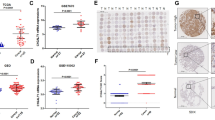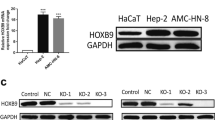Abstract
Background
β-1,4-N-Acetyl-galactosaminyltransferase 4 (B4GALNT4), an enzyme involved in ganglioside synthesis, is upregulated in many cancers. We examine B4GALNT4 expression and its relationship to prognosis in esophageal squamous cell carcinoma (ESCC).
Patients and Methods
Expression of B4GALNT4 mRNA and B4GALNT4 protein was analyzed by quantitative reverse-transcription polymerase chain reaction (qRT-PCR) and immunohistochemistry, respectively, in 17 human ESCC cell lines and/or clinical specimens from two independent cohorts of 147 and 159 ESCC patients. The contributions of B4GALNT4 to proliferation, invasion, migration, and adhesion was evaluated in ESCC cells subjected to siRNA-mediated gene knockdown. Correlations between clinicopathological parameters and B4GALNT4 expression in clinical specimens were analyzed in both patient cohorts.
Results
B4GALNT4 mRNA expression levels varied widely in ESCC cell lines, regardless of differentiation status or the originating tissue. Knockdown of B4GALNT4 significantly suppressed the proliferation, invasion, migration, and adhesion of ESCC cell lines compared with control cells. B4GALNT4 mRNA was overexpressed in ESCC tissues compared with adjacent normal esophageal tissues. High mRNA expression was significantly associated with poor disease-free survival and hematogenous recurrence, and high B4GALNT4 protein expression was also significantly related to poor disease-specific survival. On multivariable analysis, high B4GALNT4 expression was an independent predictor of poor prognosis. In both patient cohorts, high B4GALNT4 expression did not correlate with known prognostic factors, such as disease stage, lymphovascular invasion, or squamous cell-carcinoma-related antigen level.
Conclusions
B4GALNT4 influences the malignant behavior of ESCC cells. B4GALNT4 expression may serve as a novel prognostic marker, independent of established risk factors, for ESCC patients.




Similar content being viewed by others
References
Ferlay J, Soerjomataram I, Dikshit R, et al. Cancer incidence and mortality worldwide: sources, methods and major patterns in GLOBOCAN 2012. Int J Cancer. 2015;136:E359–86.
Malhotra GK, Yanala U, Ravipati A, Follet M, Vijayakumar M, Are C. Global trends in esophageal cancer. J Surg Oncol. 2017;115:564–79.
Chapman BC, Weyant M, Hilton S, et al. Analysis of the National Cancer Database Esophageal Squamous Cell Carcinoma in the United States. Ann Thorac Surg. 2019;S0003-4975:31006–9.
Hirano K, Matsuda A, Shirai T, Furukawa K. Expression of LacdiNAc groups on N-glycans among human tumors is complex. Biomed Res Int. 2014;2014:981627.
Guo W, Giancotti FG. Integrin signalling during tumour progression. Nat Rev Mol Cell Biol. 2004;5:816–26.
Che MI, Huang J, Hung JS, et al. β1, 4-N-acetylgalactosaminyltransferase III modulates cancer stemness through EGFR signaling pathway in colon cancer cells. Oncotarget. 2014;5:3673–84.
Fukushima K, Satoh T, Baba S, Yamashita K. alpha1,2-Fucosylated and beta-N-acetylgalactosaminylated prostate-specific antigen as an efficient marker of prostatic cancer. Glycobiology. 2010;20:452–60.
Anugraham M, Jacob F, Everest-Dass AV, et al. Tissue glycomics distinguish tumour sites in women with advanced serous adenocarcinoma. Mol Oncol. 2017;11:1595–615.
Hagiwara K, Tobisawa Y, Kaya T, et al. Wisteria floribunda agglutinin and its reactive-glycan-carrying prostate-specific antigen as a novel diagnostic and prognostic marker of prostate cancer. Int J Mol Sci. 2017;18:261.
Tsunoo H, Komura S, Ohishi N, et al. Effect of transfection with human interferon-beta gene entrapped in cationic multilamellar liposomes in combination with 5-fluorouracil on the growth of human esophageal cancer cells in vitro. Anticancer Res. 2002;22:1537-43.
TNM Classification of Malignant Tumours, 8th Edition. James DB, Mary KG, Christian W, eds. New York:Wiley-Blackwell, 2016:57–62.
Sato Y, Marzese DM, Ohta K, Huang SK, Sim MS, Chong K, and Hoon DS. Epigenetic regulation of REG1A and chemosensitivity of cutaneous melanoma. Epigenetics. 2013;8:1043–52.
Sato Y, Motoyama S, Nanjo H, et al. REG1A expression status suggests chemosensitivity among advanced thoracic esophageal squamous cell carcinoma patients treated with esophagectomy followed by adjuvant chemotherapy. Ann Surg Oncol. 2013;20:3044–51.
Sato Y, Motoyama S, Nanjo H, et al. CXCL10 expression status is prognostic in patients with advanced thoracic esophageal squamous cell carcinoma. Ann Surg Oncol. 2016;23:936–42.
Kanda M, Shimizu D, Tanaka H, et al. Significance of SYT8 for the detection, prediction, and treatment of peritoneal metastasis from gastric cancer. Ann Surg. 2018;267:495–503.
National Cancer Institute: The Cancer Genome Atras Program. https://www.cancer.gov/tcga. Accessed 21 Oct 2019.
Kanda M, Tanaka H, Shimizu D, et al. SYT7 acts as a driver of hepatic metastasis formation of gastric cancer cells. Oncogene. 2018;37:5355–66.
Uno Y, Kanda M, Sato Y, et al. Expression, Function, and prognostic value of MAGE-D4 protein in esophageal squamous cell carcinoma. Anticancer Res. 2019;39:6015–23.
Sato Y, Motoyama S, Wakita A, et al. TLR3 expression status predicts prognosis in patients with advanced thoracic esophageal squamous cell carcinoma after esophagectomy. Am J Surg. 2018;216:319–25.
Potapenko IO, Haakensen VD, Lüders T, et al. Glycan gene expression signatures in normal and malignant breast tissue;possible role in diagnosis and progression. Mol Oncol. 2010; 4:98–118.
Zhang F, Chen X, Wei K, et al. Identification of key transcription factors associated with lung squamous cell carcinoma. Med Sci Monit. 2017;23:172–206.
Pudova EA, Lukyanova EN, Nyushko KM, et al. Differentially expressed genes associated with prognosis in locally advanced lymph node-negative prostate cancer. Front Genet. 2019;10:730.
Seales EC, Jurado GA, Brunson BA, Wakefield JK, Frost AR, Bellis SL. Hypersialylation of beta1 integrins, observed in colon adenocarcinoma, may contribute to cancer progression by up-regulating cell motility. Cancer Res. 2005;;65:4645–52.
Clément M, Rocher J, Loirand G, Le Pendu J. Expression of sialyl-Tn epitopes on beta1 integrin alters epithelial cell phenotype, proliferation and haptotaxis. J Cell Sci. 2004;117:5059–69.
Huang MC, Chen HY, Huang HC, et al. C2GnT-M is downregulated in colorectal cancer and its re-expression causes growth inhibition of colon cancer cells. Oncogene. 2006;25:3267–76.
Baba H, Kanda M, Sawaki K, et al. PRAME expression as a potential biomarker for hematogenous recurrence of esophageal squamous cell carcinoma. Anticancer Res. 2019;39:5943–51.
Wang C, Wang J, Chen Z, Gao Y, He J. Immunohistochemical prognostic markers of esophageal squamous cell carcinoma: a systematic review. Chin J Cancer. 2017;36:65.
Xiao Z, Jia Y, Jiang W, Wang Z, Zhang Z, Gao Y. FOXM1: A potential indicator to predict lymphatic metastatic recurrence in stage IIA esophageal squamous cell carcinoma. Thorac Cancer. 2018;9:997–1004.
Kupcinskaite-Noreikiene R, Ugenskiene R, Noreika A, et al. Gene methylation profile of gastric cancerous tissue according to tumor site in the stomach. BMC Cancer. 2016;16:40.
Maus MK, Hanna DL, Stephens CL, et al. Distinct gene expression profiles of proximal and distal colorectal cancer: implications for cytotoxic and targeted therapy. Pharmacogenomics J. 2015;15:354–62.
Oppedijk V, van der Gaast A, van Lanschot JJ, et al. Patterns of recurrence after surgery alone versus preoperative chemoradiotherapy and surgery in the CROSS trials. J Clin Oncol. 2014;32:385–91.
Sohda M, Kuwano H. Current status and future prospects for esophageal cancer treatment. Ann Thorac Cardiovasc Surg. 2017;23:1–11.
Veskimäe K, Scaravilli M, Niininen W, et al. Expression analysis of platinum sensitive and resistant epithelial ovarian cancer patient samples reveals new candidates for targeted therapies. Transl Oncol. 2018;11:1160–70.
Acknowledgment
We thank Anne M. O’Rourke, PhD, from Edanz Group (www.edanzediting.com/ac) for editing a draft of this manuscript.
Author information
Authors and Affiliations
Corresponding author
Additional information
Publisher's Note
Springer Nature remains neutral with regard to jurisdictional claims in published maps and institutional affiliations.
Electronic supplementary material
Below is the link to the electronic supplementary material.
Rights and permissions
About this article
Cite this article
Baba, H., Kanda, M., Sato, Y. et al. Expression and Malignant Potential of B4GALNT4 in Esophageal Squamous Cell Carcinoma. Ann Surg Oncol 27, 3247–3256 (2020). https://doi.org/10.1245/s10434-020-08431-8
Received:
Published:
Issue Date:
DOI: https://doi.org/10.1245/s10434-020-08431-8




